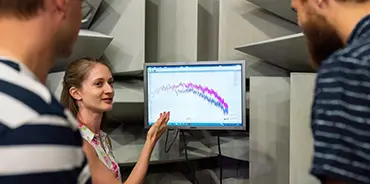Charting a course for the future of quantum computing
In this final post in our series investigating the growing importance of quantum computing, dunnhumby Data Scientists David Hoyle and Ross Williams look to the future and share their views on how the events of the next few years will influence how commercial organisations can capitalise on the quantum revolution.
Throughout the previous posts (here and here) in this series, we’ve been keen to point out some of the current limitations that hamper quantum computing’s (QC) ability to tackle the commercial challenges that organisations face today. While a huge amount of progress has been made, particularly in the past few years, we aren’t yet at the point at which the average business can easily capitalise on the inherent potential of quantum computing.
What exactly needs to change, then, to get us past that hurdle? And just how far away are we from a future in which QC is a ubiquitous tool?
While it isn’t possible to answer either of these questions without resorting to some degree of speculation, we can at least make some educated guesses based on the current trajectory of development. There are five key areas to focus on when considering the point at which QC becomes a genuinely viable commercial tool.
These are:
- Hardware
- Software
- Algorithms
- Applications
- Quantum-as-a-service (QaaS)
Here are our thoughts on the developments that we’ll see in each of those fields in the near future.
Hardware: Advances will be driven by QaaS and external investment
Stating that we expect investors to flock around quantum startups that have partnered with the likes of Amazon and Microsoft, probably isn’t going to surprise too many people. It remains an important point to make however, since that investment is likely to drive the hardware improvements necessary to increase the computational power on offer to QaaS customers.
As that investment continues, we’re likely to see significant advances in both the qubit capacity of QaaS machines and a reduction in the noise afflicting those computers.
Software: More developers means faster progress
While the creation of quantum hardware is likely to remain exclusive to a select group of well-resourced tech giants and startups, software development has a much lower barrier to entry. As a result, and as the QaaS market continues to expand, we expect that we’ll see continued growth in the numbers of start-up companies specialising in QC software solutions.
The most important aspect of this trend is that it will likely lead to the creation of a greater number of high-level language abstractions. Compared with fine-grained controls, these tend to reduce the level of skill required to operate a quantum computer, ensuring that QC can be exploited by a wider audience than just highly-trained specialists.
Algorithms: Applications to practical problems will drive development
Today, many QC solutions draw from a relatively small pool of algorithms. Because new algorithms have traditionally emerged at a slow pace, it is likely that QC will continue to rely on these core methods for the foreseeable future.
What is likely to change is that these algorithms will be applied to more realistic and challenging problems. As this happens, we’ll see a gradual revolution in QC’s ability to tackle issues that are much closer to those faced by commercial entities. This will in turn bridge the gap between theoretical possibility and practical application.
Applications: As the industry learns “what works”, QC application will broaden
As with any developing technology, much of the discourse around QC tends to be filled with unrealistic ideas about its potential. That hype is likely to dwindle over the next few years, leaving us with a much more realistic picture of what quantum computers can actually accomplish.
On the road to this more pragmatic future, one of the things that we are likely to develop is a more nuanced understanding of the application of QC to commercial optimisation problems. This will enable us to tackle a wider range of operational challenges, broadening the potential appeal of QC.
QaaS: Growing adoption will fuel further advances
In many ways, progress in this fifth area is dependent largely on some of the above predictions coming to fruition. If investment slows and development falters, QaaS will clearly end up on a longer path towards widespread commercial adoption.
Theoretically, though, as QaaS-based QC becomes more relevant, effective, and easy-to-use, a growing number of corporate users should be drawn to the technology. A key turning point to look out for will be if and when users are able to integrate quantum solutions into a wider workflow. This will require and drive enhancements in the capacity, stability, and performance of QaaS.
As with QC as a whole, though, the real test for QaaS will come in its ability to combine ease of use with real, near-term competitive advantage for commercial customers.
All of this is, of course, merely speculative analysis. One thing that is particularly important to bear in mind is that while we believe that many of the possibilities outlined above will come to pass within the next three to five years, there is no guaranteed timeline for QC.
However, the promise of a paradigm shift in computation tomorrow requires a shift in your organisation’s mindset and capabilities today. It is an exciting time to embrace quantum computing.
This blog discusses themes covered in greater depth in our new report on quantum computing: “Demystifying quantum computing for commercial companies.” Download a complimentary copy of the report here.
The latest insights from our experts around the world
Disaggregating Forecasts
The six drivers of private brand innovation
AI's Regulatory Crossroads: Innovation vs. Control

Speak to a member of our team for more information



